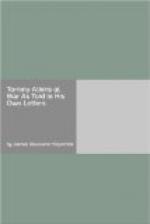History seems to be repeating itself in amazing ways in this war. Just as the charge of the Light Brigade at Balaclava has been reproduced by the 9th Lancers, so the Scots Greys and 12th Lancers have reproduced the famous charge of the “Greys” at Waterloo. This is the fight which aroused the enthusiasm of Sir Philip Chetwode, for his brigade went through the German cavalry just as circus horses might leap through paper hoops. “I watched the charge of the Scots Greys and 12th Lancers,” writes Sergeant C. Meades, of the Berkshires. “It was grand. I could see some of the Germans dropping on their knees and holding up their arms. Then, as soon as our cavalry got through, the Germans picked up their rifles and started firing again. Our men turned about and charged back. It was no use the Germans putting up their hands a second time. Our cavalry cut down every one they came to. I don’t think there were ten Germans left out of about 2,000. I can tell you they had all they wanted for that day.” An officer of the dragoons, describing the same charge, says the dragoon guards were also in it, and that his lads were “as keen as mustard.” In fact, he declares, “there was no holding them back. Horses and men positively flew at the Germans, cutting through much heavier mounts and heavier men than ours. The yelling and the dash of the lancers and dragoon guards was a thing never to be forgotten. We lost very heavily at Mons, and it is a marvel how some of our fellows pulled through. They positively frightened the enemy. We did terrible execution, and our wrists were feeling the strain of heavy riding before sunset. With our tunics unbuttoned, we had the full use of our right arms for attack and defense.”
Another charge of the Scots Greys is thus described: “Seeing the wounded getting cut at by the German officers, the Scots Greys went mad, and even though retreat had been sounded, with a non-commissioned officer leading, they turned on the Potsdam Guards and hewed their way through, their officers following. Having got through, the officers took command again, formed them up, wheeled, and came back the way they went. It was a sight for the gods.”
Another episode was the capture of the German guns by the 2nd and 5th Dragoons. An officer of the 5th gives an account of the exploit. “We were attacked at dawn, in a fog,” he relates, “and it looked bad for us, but we turned it into a victory. Our brigade captured all the guns of the German cavalry division, fourteen in all; the Bays lost two-thirds of their horses and many men. The Gunner Battery of ours was annihilated (twenty left), but the guns were saved, as we held the ground at the end. This was only a series of actions, as we have been at it all day, and every day. My own squadron killed sixteen horses and nine Uhlans in a space of 50 ft., and many others, inhabitants told me, were lying in a wood close by, where they had crawled. We killed their officer, a big Postdam Guard, shot through the forehead. L Battery fought their guns to the last, ‘Bradbury’ himself firing a gun with his leg off at the knee; a shell took off his other leg. He asked me then to be carried from the guns so that the men could not hear or see him.”




